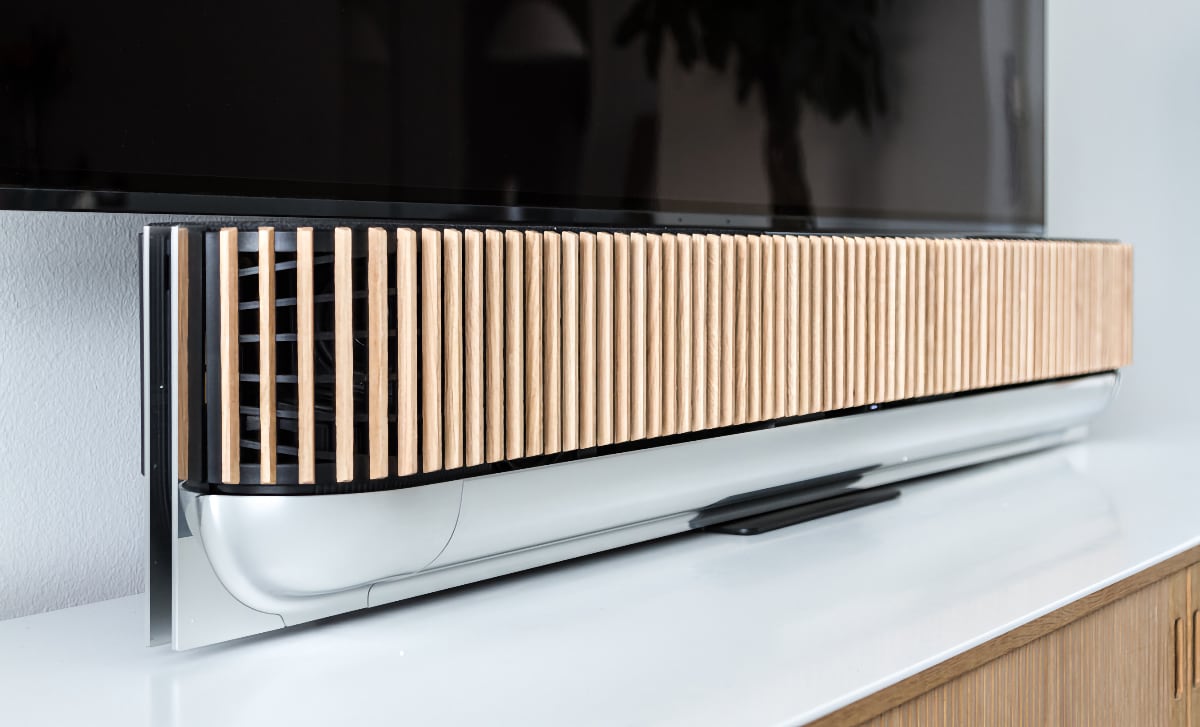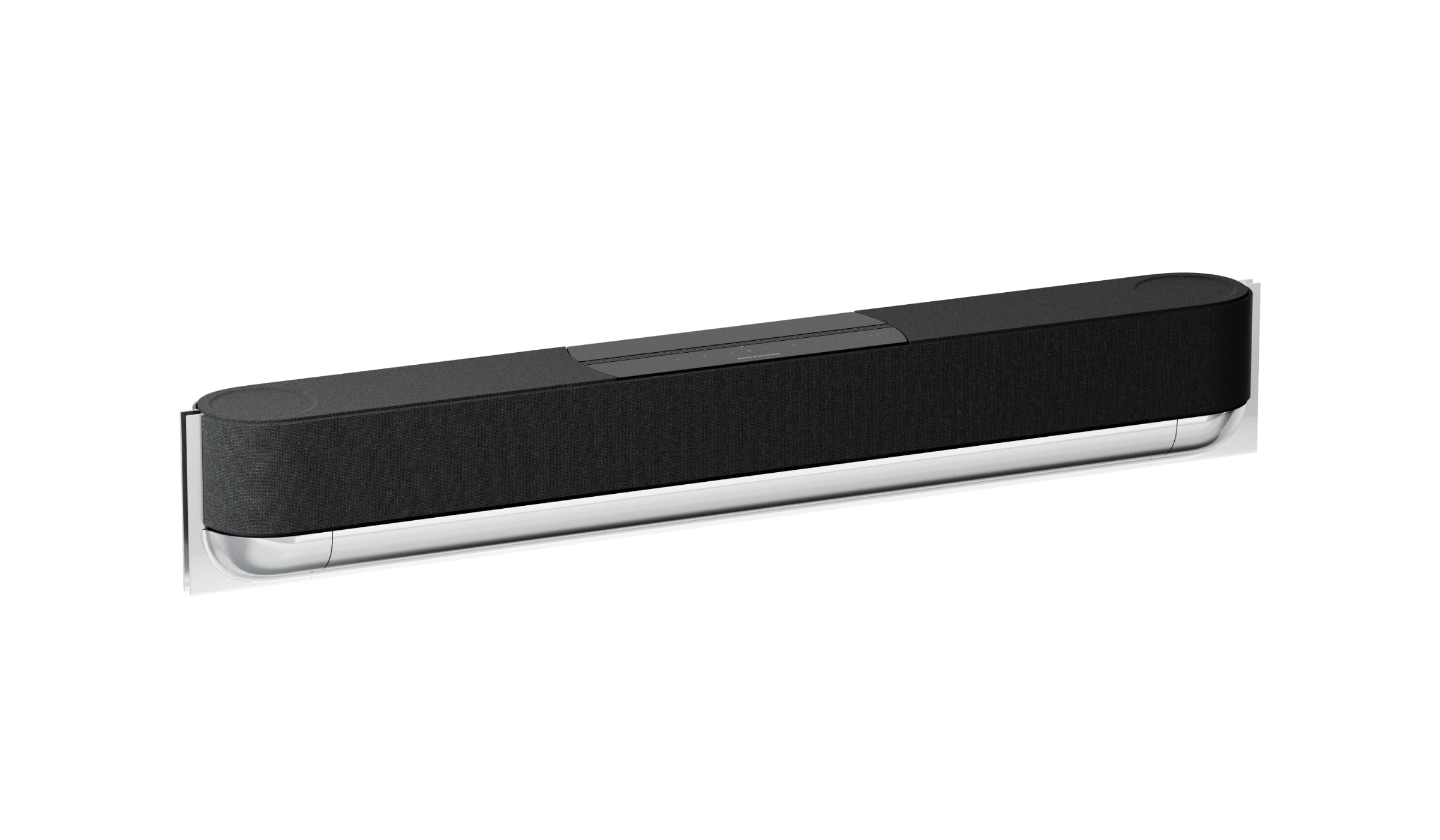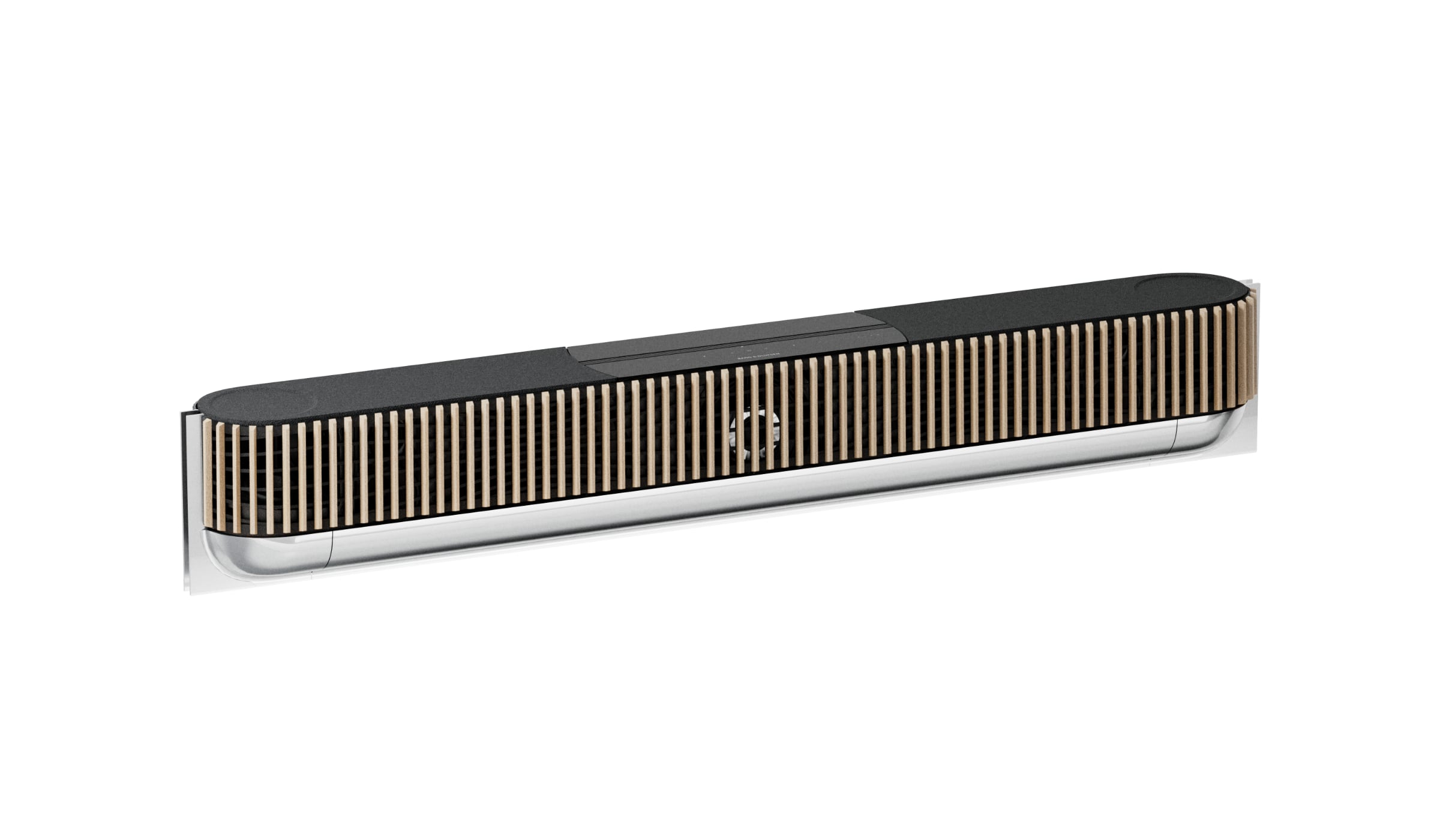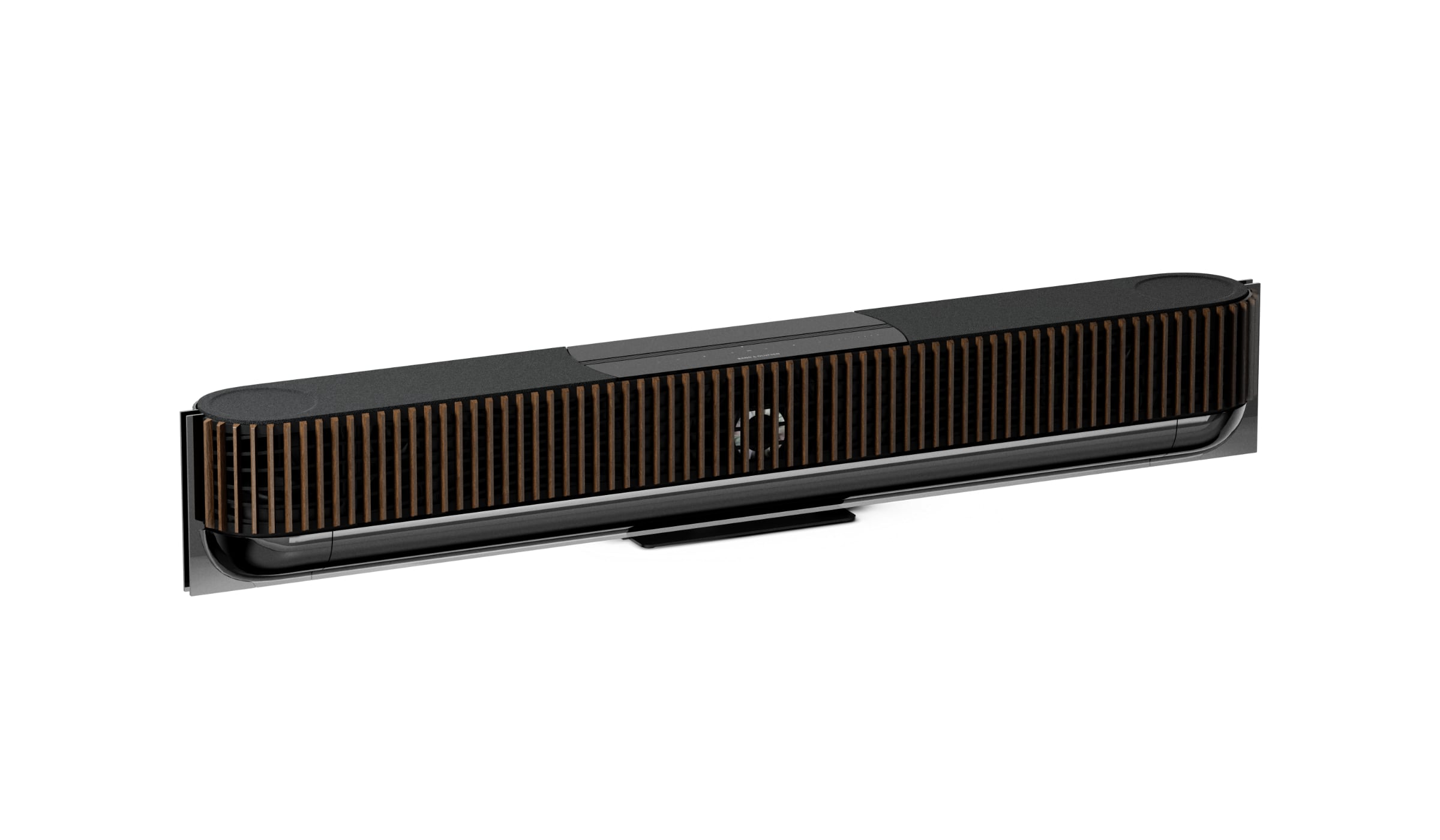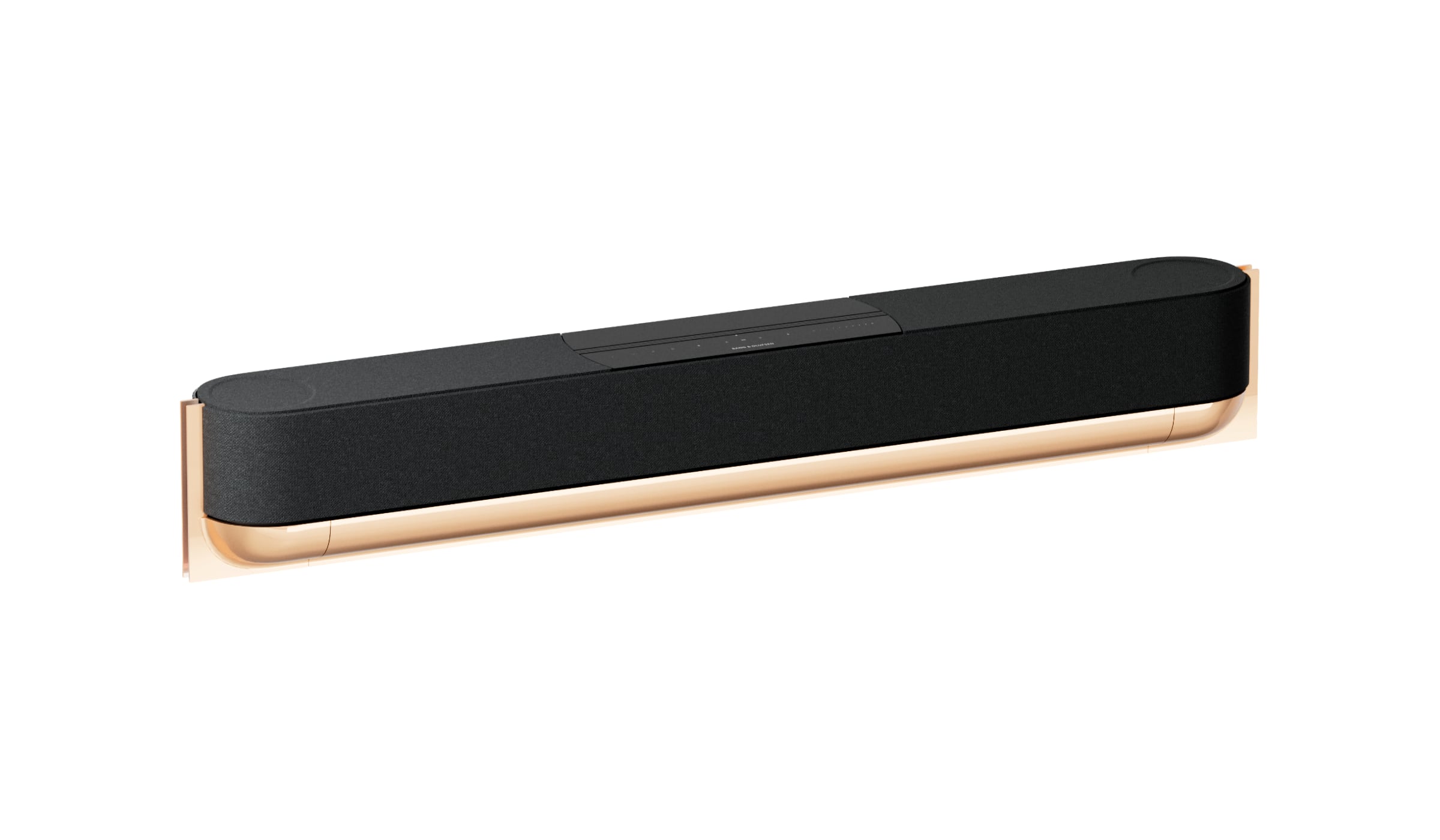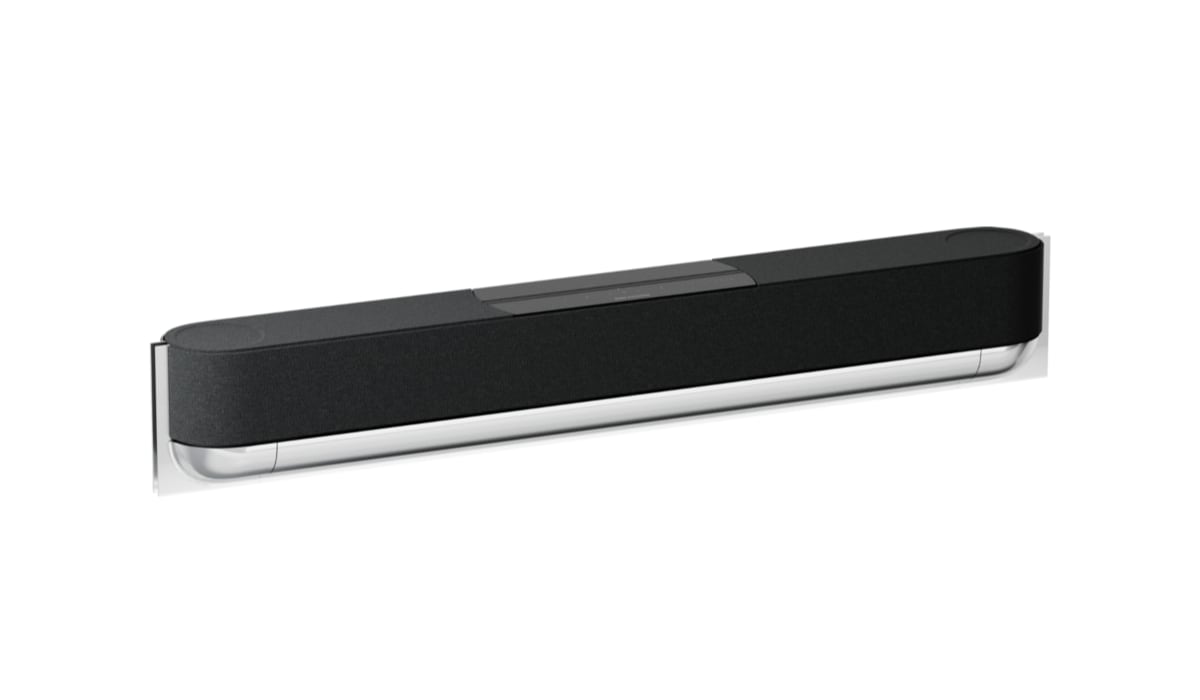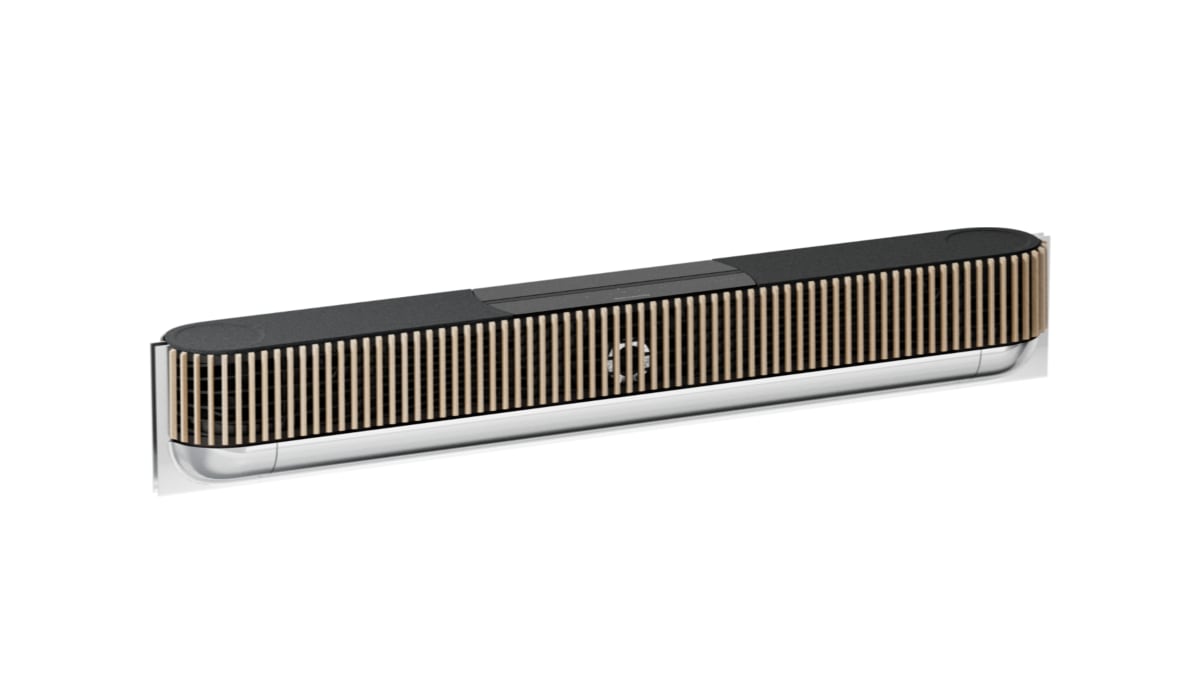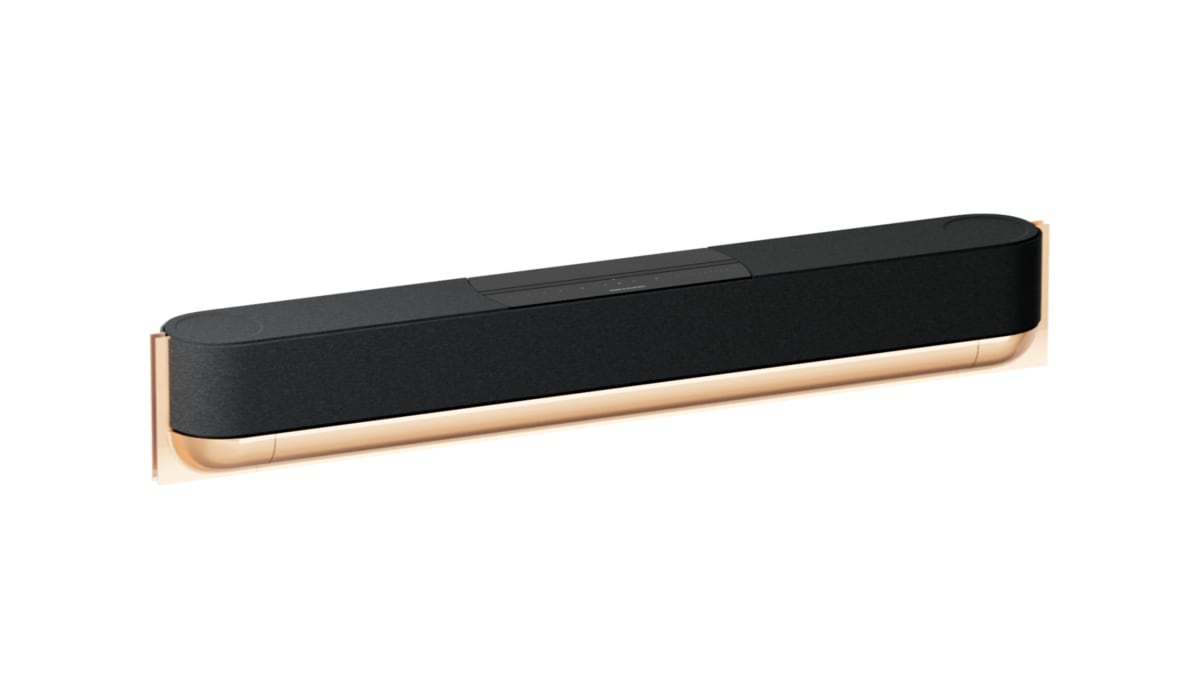Beosound Theatre – specifications
| |
|---|
| Design | Soundbar |
| - colors | silver, black or gold with oak wood, aluminum, polymer or fabric | | - dimensions (HxWxD) | 9,7 x 122,2 x 15,7 cm | | - weight | 18 kg | | - table stand | | | - wall mounting | | | - floor stand | |
|
|
| Speakers | 5.0.2 channels (expandable to 7.1.4) |
| - tweeter | 2x 1" tweeters | | - bass | 2x 6,5" bass units | | - center | 1x 5,25" mid-range + 1x 1" tweeter | | - mid-range | 2x 3" mid-range | | - fullrange | 4x 2,5" fullrange | |
|
| Audio formats | Dolby |
| - Dolby Atmos | | | - Dolby TrueHD | | | - Dolby Digital Plus | | | - Dolby Digital | | | - DTS:X | | | - DTS | | | - LPCM | (7.1, Dolby MAT) | | - MPEG-H | |
| - Hi-Res Audio | | |
|
|
|
| HDMI in/out | |
| - HDMI inputs | | | - HDMI ARC / eARC | / | | - passthrough 4K | | | - passthrough 4K 120Hz | | | - passthrough HDR10 | | | - passthrough Dolby Vision | | | - passthrough VRR | | | - passthrough QMS | | |
|
| Inputs | 4x Ethernet, 2x PUC, 3,5mm analog (with adapter), USB-C (with analog option), 1x microphone input |
| Outputs | HDMI eARC, WiSA (8x wireless Powerlink), 8x Powerlink |
| WiFi | (WiFi 5) |
| Wireless audio protocols | Yes |
| - Chromecast | | | - AirPlay 2 | | | - Bluetooth | (5.1) | | - Spotify Connect | | | - Other | WiSA, Beolink |
|
|
| In the box | Microphone, wall bracket, table stand, user manual, power cable |
First impressions
We received a brand new sample of the soundbar for testing, which required us to set everything up from scratch. Most soundbars in the price range of under 2500 USD have the standard black bar shape, including the
Sennheiser Ambeo. However, the Bang & Olufsen takes a different approach with Beosound Theatre, with a raw aluminum base and a front panel made of oak slats.
The Beosound Theatre's design is unique and eye-catching. Its front panel is available in different colors or can be purchased with front fabric (which reduce the price), while the aluminum base is available in black and bronze at no additional cost. Its shape is atypical, resembling a boat, which makes it taller than it is deep but enables the installation of larger bass units. If you plan to place the Theatre on a piece of furniture under a wall-mounted TV, be aware of its height.
In our setup, we had a 22 cm gap between our TV furniture and the TV on the wall, and the Theatre fit perfectly below it. The wooden slats give the speaker an almost sculptural appearance, which garnered positive comments from visitors during the test period. It is a piece of hardware that you won't regret having standing in front of your TV, unlike most black soundbars on the market.
The materials exude the usual exclusive B&O style, with excellent craftsmanship and top-notch quality that naturally comes with a high price. Basic functions are controlled via a glass panel on top, similar to most soundbars out there. There is no graphical display for input or audio format – this information is found in the accompanying app. Touch buttons and volume indicators light up when approached and dim after a short period.
Removing the panels, we find two relatively large 6.5" bass drivers on the speaker side, similar to those found at the bottom of B&O's active Beolab 28 speakers. Additionally, there are two midrange drivers and tweeters, which are also used in the BL28. There are also four full-range drivers for the side and top channels, and the center channel consists of a specially designed midrange and tweeter built together into a coaxial unit, visible through the front grilles. Above the center speaker is a small jack for attaching the included measurement microphone used during system room calibration. It may not be the most practical placement if one often moves around or adds new speakers since the front panel needs to be removed to provide access.
On the back there is a port panel with a 4-port HDMI switch, one of which acts as an eARC output to the TV, and the remaining three are of the HDMI 2.1 type. Other connections include B&O's own Powerlink, which can connect 8 wired speakers with its 4 ports (and an additional 8 via Wireless Powerlink – WiSA), an Ethernet port dedicated to pairing with an LG TV, and 3 Gigabit Ethernet ports that function as a switch for other gear (1 uplink, 2 downlink). When using B&O's remote control, Theatre also features 2 PUC outputs, which is B&O's connection to send IR signals to control external devices that may not be controllable via HDMI CEC. This system has existed since B&O made picture tube TVs and can best be compared to a universal remote with a database of supported devices. We have found a similar system on TVs from LG and Samsung but not on any soundbars. We will delve into the reasoning behind this in a bit.
Beosound Theatre comes without rear speakers or a subwoofer by default. However, Beo&O's extensive range of active speakers can be added to the system using the company's Powerlink connection and, more recently, WiSA standard. Up to eight wired active speakers and eight wireless WiSA models can be connected to Theatre, and options to pair and adjust them to the system offers is so advanced and flexible that it is beyond the scope of this review. The WiSA connection allows two-way communication, meaning the system can determine the characteristics of the connected speaker and adjust sound accordingly. This makes it possible, for example, to direct more diffuse bass reproduction to the speakers that are best equipped to enhance the experience.
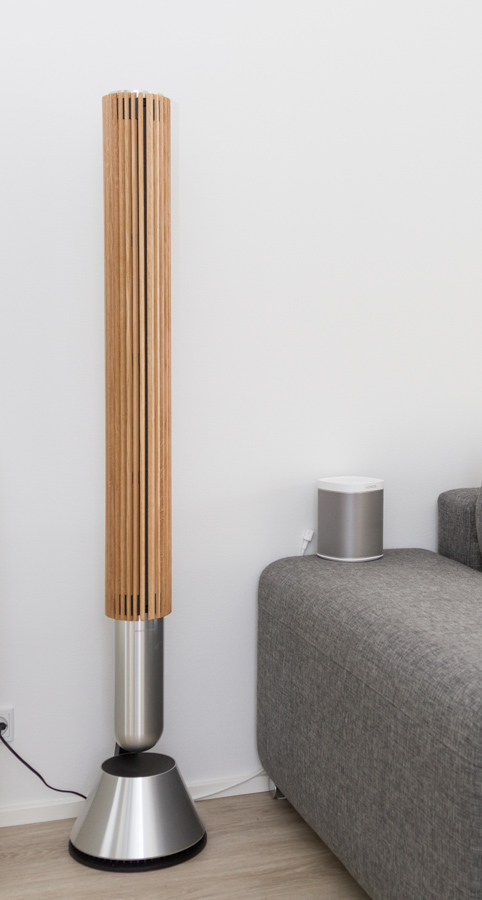
In our setup, a pair of Beolab 28 speakers were connected as rear speakers via WiSA, taking full advantage of the speakers' two subwoofers to provide a higher bass impact. Theatre can also utilize the properties of older B&O speakers that lack two-way communication by manually specifying which speakers are in use – the system already knows the characteristics of speakers dating back to the active Penta models from the mid-80s. B&O has indicated that Theatre could support even older models, but there are currently limits to its capabilities in this regard.
B&O explained that there is no obstacle to expanding support to even older models, but currently, there are limits. As a buyer of Theatre, you can combine the soundbar with older equipment you may already have and gradually build on the system, which is something we missed in the cheaper
B&O Beosound Stage soundbar. In the market for used products, you can often find older models at a reasonable price, so you're not limited to pairing speakers from the same vintage as the soundbar. Compared to a system like Sonos, you can also connect older Play:1 speakers as rear speakers to their soundbars, but it's uncertain if that remains possible 25 years from now with, for example, a newer version of 'Sonos Arc'. Unlike Sonos, B&O's external speakers are not locked for use with Theatre, and during our review the rear speakers (Beolab 28) appeared both as a stereo pair (for music) and as rear speakers (for TV audio) and an extra subwoofer when the TV was turned on. This configuration can be configured via sound profiles.
In 2017, B&O partnered with LG to use LG OLED TVs in their models. Unlike other TV manufacturers, B&O chose a different path by not buying panels from LG Display but instead purchasing the entire TV from LG Electronic and mounting it on top of their own speaker system. Back then, the model was called BeoVision Eclipse, and the TV was a modified LG C-series, but since then, B&O and LG have refined the concept, so today you can buy the LG TV separately and get it at the best daily price. The concept was continued with Beosound Stage, which gave access to using the luxurious BeoRemote One remote control to control both sound and LG TV, as if it was a dedicated B&O setup, and this feature has naturally been transferred to Beosound Theatre. Here, the control of external devices via the PUC system also comes into play, as the addition of this essentially transforms the combination of Theatre, an LG TV, and a BeoRemote One into a Beovision TV.
Theatre comes with various mounting solutions that harmoniously connect the soundbar with either an LG C- or G-series TV, which can then be controlled with the BeoRemote One. Other TV brands can also be mounted, but the control via the BeoRemote One will be limited, as deeper integration with the TV's control system is only available with an LG model. To match the design of Theatre with the choice of TV, the aluminum "wings" on the sides of the soundbar can be changed to match TVs in 55, 65, and 77-inch sizes. If you use an OLED TV from another brand than LG, the width will likely match approximately, as LG Display still supplies most OLED panels (Panasonic, Philips, Sony, Hisense etc.)
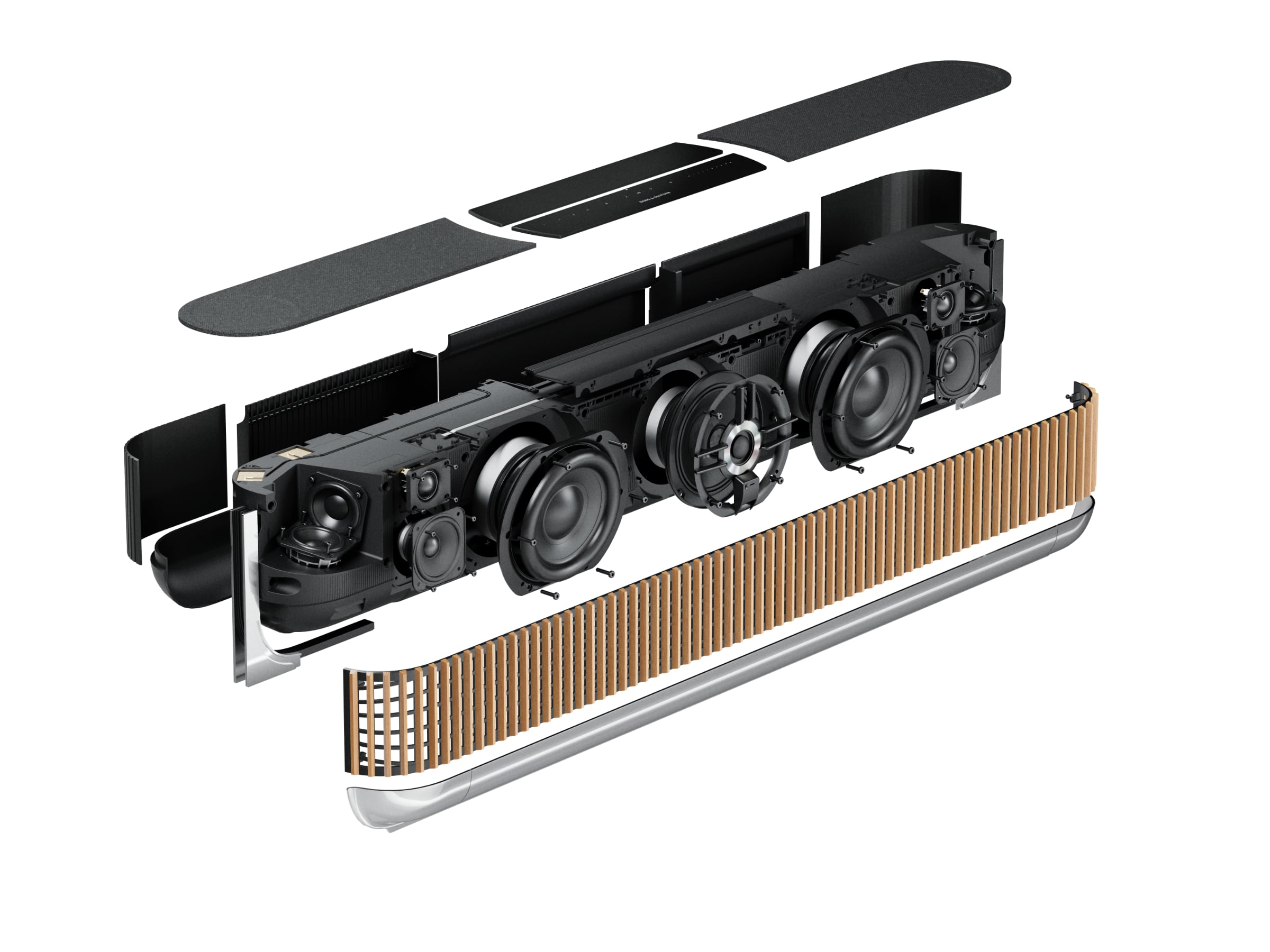
Set up
Some systems we've tested have been easy to set up using an on-screen menu on the soundbar's HDMI port and don't rely on the manufacturer maintaining an app, while others are deeply dependent on their own ecosystem to get started. B&O definitely falls into the latter category, and you won't get far without frequently opening their app. Fortunately, it's a functional one.
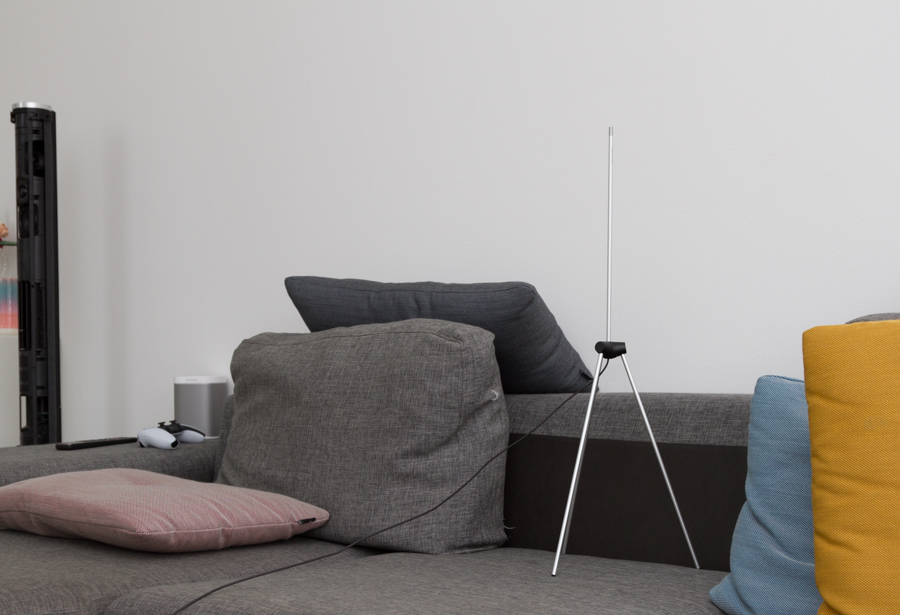
The initial configuration was relatively simple, and the app guides you through the process of getting the speaker online and calibrating the sound using the included measurement microphone. Room calibration is linked to a sound profile in the app, which defines which speakers – both physical and virtual – should be included. This makes it easy to create different profiles tailored to different seating positions and configurations of connected speakers. You can either recalibrate for each profile or duplicate an existing one and start from there. This was a straightforward way to test the setup in very different combinations along the way, and this feature is a strong card for those who want to use their speakers in the living room for more than just TV sound.
Connecting physical speakers is also done through the app, where you can define their placement and perform a new calibration. If the speakers support the B&O app, they must first be added to it and then added via the channel configuration on a given sound profile in Theatre. Does that sound complicated? It's not pure plug-and-play and may require a bit more technical skill than when connecting a Sony subwoofer to a Sony soundbar. The connection between Theatre and WiSA speakers is via 5 GHz frequencies, and while there were no dropouts between the soundbar and rear speakers, there was initially some trouble keeping the connection between the master/slave configuration used by Beolab 28. When the two rear speakers were wired together, there were no issues. At no point during the test was there a dropout between the front and rear. WiSA operates on the 5 GHz frequency band, which can be affected by which channel you use on your WiFi router, and since I have access points evenly distributed around my house, there was potential for interference. If you move your wireless network to the higher channel slot, WiSA should be more reliable.
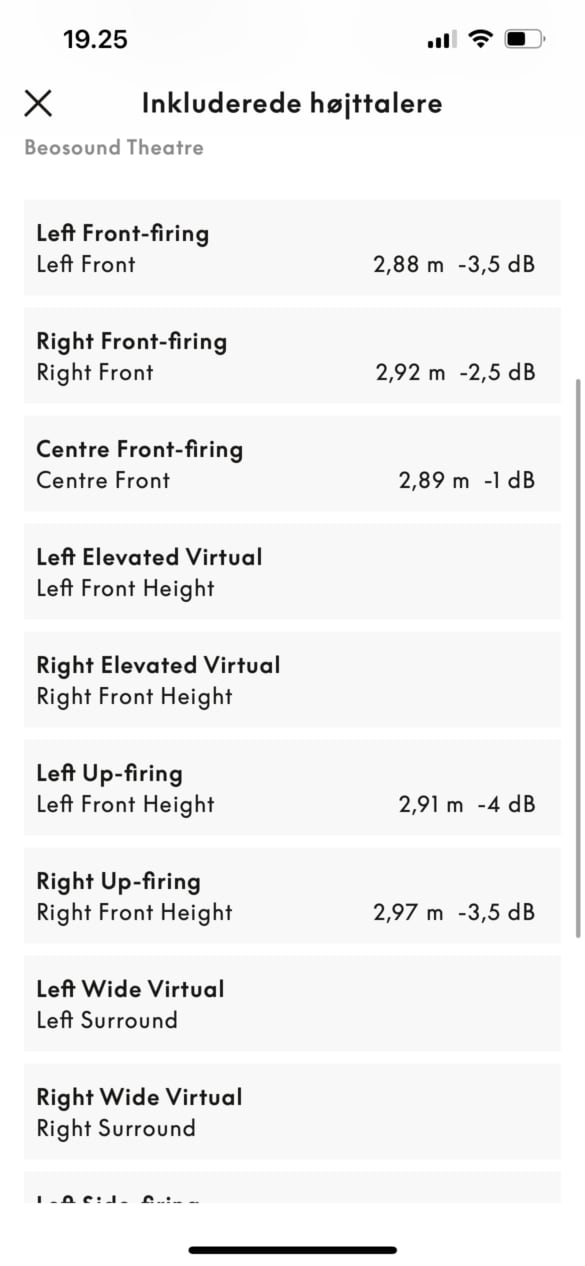
By default, Theatre does not add all virtual audio channels. To achieve extra width and height in the sound image, two virtual top and side channels need to be added via the app. If you are technically inclined, this should not be a problem, but if you are less comfortable with advanced settings, you may need support from the dealer or one of their installers.
To facilitate sound adjustments, B&O has provided a 2-axis diagram that can steer sound towards different preferences, underlyingly adjusting things like tilt and frequency response on the speaker. This is "on top" of the room calibration, which seeks to balance the sound according to the listening position while still achieving the sound that B&O has established as the starting point.
Beosound Theatre does not come with a voice assistant, so you won't find Google Assistant or Alexa. If you want to control your system via voice, B&O recommends an external device. However, you can stream your audio content to the speaker via various services, including DLNA, Deezer, and B&O's own Beolink Multiroom, all integrated directly into B&O's app, as well as connections such as Airplay 2, Chromecast, Spotify Connect, and Bluetooth. With the latter connections you can use the respective music apps on your phone.
If you want to control external devices via an IR diode (sold separately), these devices can be added via the app. However, this only makes sense if you also connect a BeoRemote One to the soundbar, as added devices can now be directly controlled with it. Additionally, the HDMI switch in Theatre should be used to connect the external device, which may not be of interest to everyone. One disadvantage of using the HDMI switches located at the back of a soundbar is that the duration of the black screen you get when switching video sources (e.g., between SDR and HDR, or when switching frequencies) is extended. This can be a nuisance, and personally, it usually deters me from using the switch in a soundbar or similar as the black screen duration almost doubles when routing through Theatre.
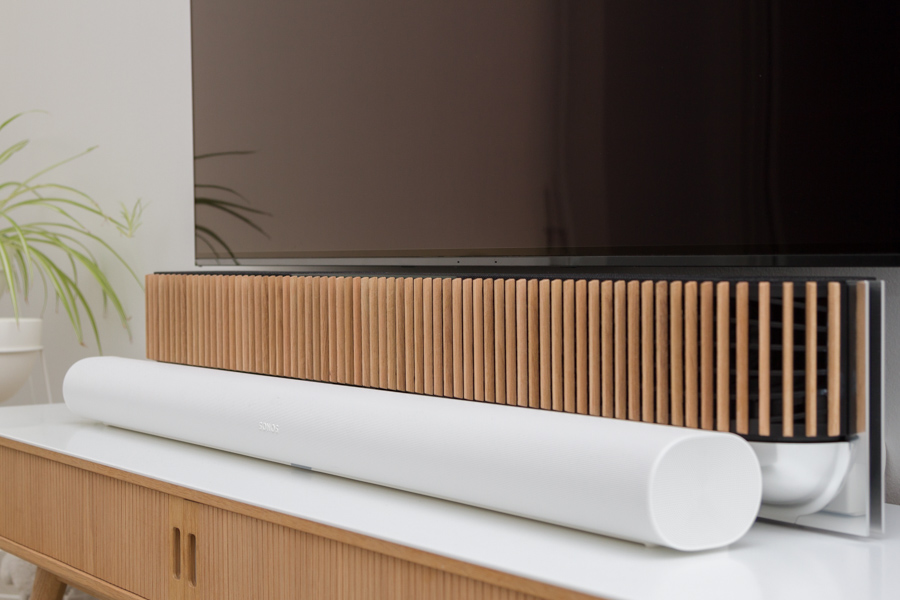
During the review, I had a
Sonos Arc with rear speakers and a subwoofer standing for comparison. I had connected an Apple TV 4K and a PlayStation 5 to the TV, and the soundbar was connected via HDMI eARC to a Sony A9F/AF9 OLED TV. We intentionally refrained from testing with LG TV, as we wanted to evaluate the soundbar as a separate product.
Before we dive into sound quality, it's worth noting that the Theatre consumes 8W in standby mode, which is relatively high compared to modern standards. Other systems get away with less than half of that, and in pure standby mode, the Theatre would cost 70 kWh per year.
Listening test: Music
Of course, a soundbar is primarily intended for TV sound, but with a price tag of $6900 / €6500 / £5600 most people would likely expect it to be a more complete solution in the living room. Specifically, we would expect it to also function as a decent music system in the living room.
When testing the music capabilities of new soundbars in general, I usually compare them in an A/B test with my own Sonos Arc setup, where I disconnect the rear speakers depending on the circumstances. If I were to describe the difference between Theatre and
Sonos Arc, as I fade between the two, it could best be described as the change you experience when listening to music from speakers located in an adjacent room and then opening the door. At first, you are struck by the clarity that the coaxial center unit in Theatre brings to the table, where the vocals are razor-sharp and clear. In comparison, the Sonos Arc sounds downright muddy. The next thing you notice is that the bass is very well-controlled and tight, while the Arc sounds diffuse and muddy. The bass has a punch that reminds me of the
Sennheiser Ambeo, and this precise reproduction is simply not possible with the small bass drivers found in most other soundbars.
The next thing you will notice with Theatre is how ultra-clear vocals are very centered in the soundstage. The wide stereo perspective is not present in stereo sound, and you are rarely in doubt about where the speaker is located. However, the sound is very well-balanced, and it is clear that there is room for some relatively solid bass drivers in the enclosure. You need to turn up the volume a bit to fully unleash the speaker, and there is plenty of headroom to fill the room. Compared to the much less powerful Sonos Arc, the Theatre seems like a monster of excess, handling the low frequencies much better than the Sonos Arc + Sub.
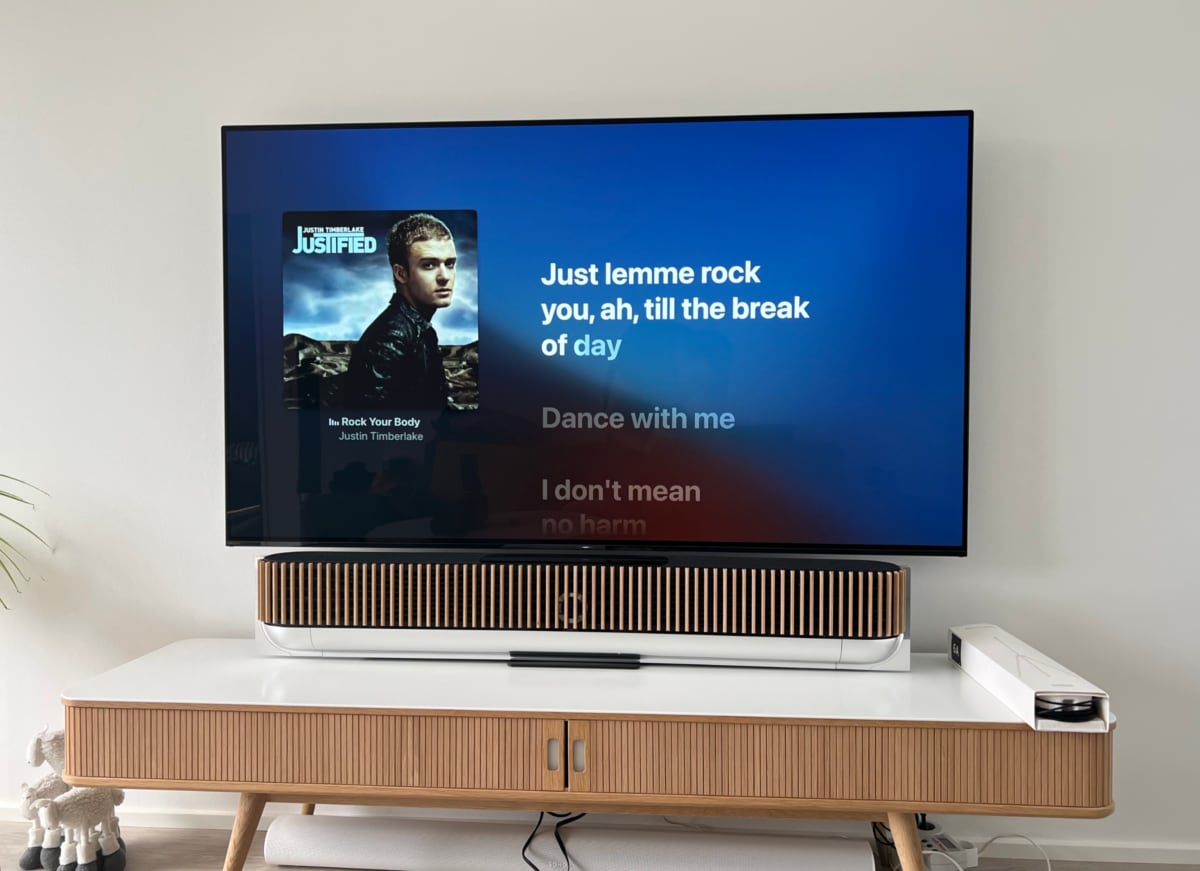
The well controlled bass of Theatre was put to the test with some of my favorite test tracks, such as the Big Phat Band's "Sing Sang Song", with its delicious bass lines and tight trumpets, making the entire track a joy to listen to on the Theatre. To test the capacity to play deeply without drowning out the vocals, I use the MTV live version of "Hotel California" by The Eagles, one of their variants that has a deep bass drum sound. Once again, the vocals can sound a bit
too sharp, and I find myself opening the B&O app to adjust the sound by pulling the preference towards a "warm" sound, where the midrange and treble are toned down slightly, but without sacrificing the precise bass reproduction.
For those who want to expand the soundstage without upmixing, there are now many music options geared towards spatial sound, and with the Apple TV 4K box, most people can find something that should suit their musical taste, as Dolby Atmos soundtracks are available for everything from The Beatles or Rolling Stones to The Weeknd or M.I.A. One of the local band of my country, Lukas Graham, has released their latest album in Atmos and placed in the sweet spot, without rear speakers connected and with as many virtual channels added as possible, I achieve a bit more spatial richness. I still miss a wider soundstage, and the very clear center unit means that you never doubt which direction the TV is facing. The vocals are very centered – but also fantastically clear. The Theatre is particularly capable in the deep tones, and there is no need to add a dedicated subwoofer to this setup until the end, when all the other surround positions have been filled with dedicated speakers.
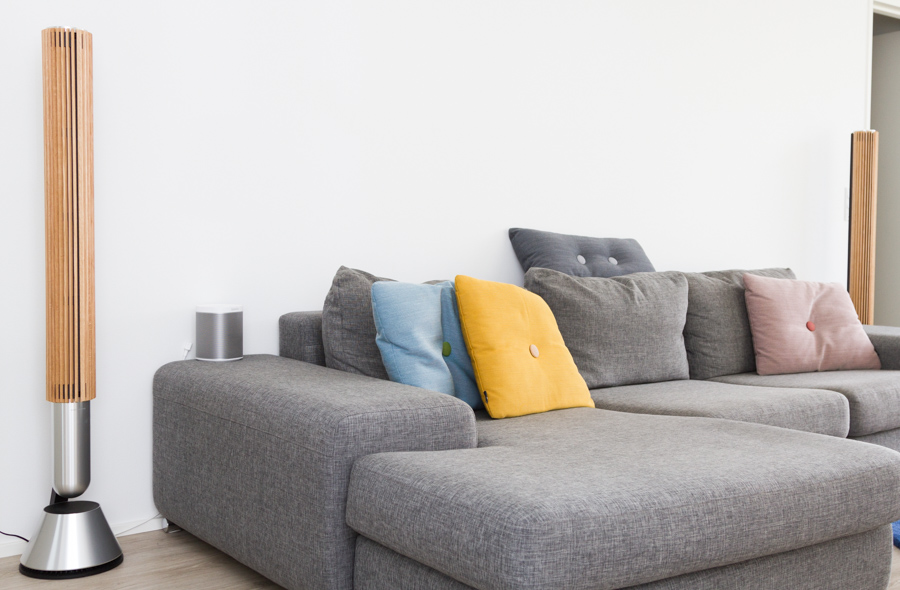
In order to elevate the surround experience, I added a pair of Beolab 28 speakers as rear speakers, as described above, and in this constellation, Theatre takes advantage of the powerful bass units in each of these Beolab 28 speakers. At the same time, the Atmos sound is adjusted via the measurement microphone to take into account the placement of all speakers. Compared to many of the other Atmos soundbars I have had in my living room, Theatre does not fill the room to the same extent as, for example, the Sennheiser Ambeo or even the Sonos Arc, and even with rear speakers connected, the spatial sensation feels much more subdued. There is still a very focused vocal from the center unit, but the left/right channels do not manage to spread out enough to provide an enveloping experience. When speaking to one of the developers at Theatre about my experience, B&O's approach has been to prioritize being faithful to the source rather than delivering the Atmos wow effect, which can be found as a setting option on many of their competitors' speakers. B&O is considering adding the ability to turn up the Atmos effect with one button press, but it will not be the default setting as their experience is that it provides a tiring listening experience in the long run. For music playback, I might have preferred to have had some degree of maximum width in the sound if Theatre were to act as the sole audio source for music listening.
With many other types of soundbars, one would have to shrug and made up their mind whether to live with the limitations that the soundbar alone contains, but this is precisely where the hefty price tag of Theatre must be justified; you can add up to 16 additional speakers, which lift the system to the full Dolby Atmos experience, which is not possible with other soundbars. With this option, you are of course moving into the same market as expensive dedicated surround systems also operate in, and strictly speaking most of these systems can also take advantage of B&O's active speakers, so this argument cannot stand alone, but it makes Theatre significantly different from other soundbars at this time.
Using Beolab 28 in the constellation that I have used here, as rear speakers, is overkill for the vast majority and personally I would probably move them to act as front speakers instead and place a set of speakers sourced from the second-hand market at the back. Now, this is not intended to be a review of Theatre + Beolab 28 at a total price of 20,000+ USD, and much cheaper speakers can certainly also elevate the surround experience – perhaps even more so if chosen carefully. If I were to make a suggestion, a set of used Beolab 3 with an acoustic lens might be worth considering. However, I would prioritize adding front speakers as well to get a wider soundstage, so the center channel becomes less dominant.
Dare I go so far as to say that for music listening, I personally would not go with Theatre without a set of front speakers, precisely because the center channel is so dominant?
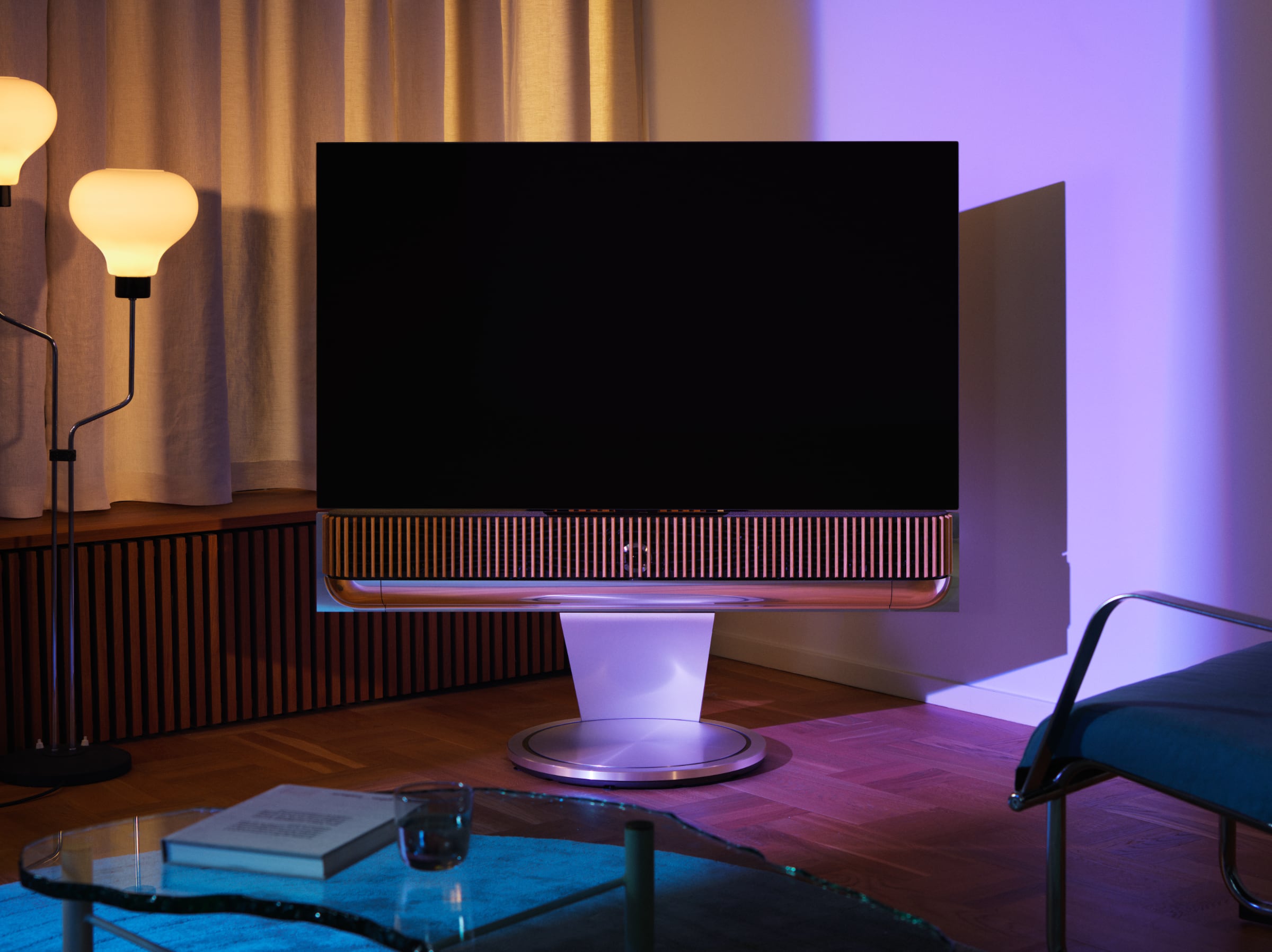
Listening test: Movies
The Beosound Theatre is primarily designed for film enthusiasts who desire a top-notch movie-watching experience. While music listening with the device is quite centered without a wide sound perspective, the film audio is incredibly focused, with clear dialogs that work well and reflect how the center channel is utilized in a surround setup. This feature results in crystal-clear speech reproduction in films, but does not draw attention to the lack of audio width in the same manner.
While the audio lacks spatial movement, ambient sounds – background sounds – fill the room nicely. Like all other soundbars, Theatre cannot project audio behind the listener and as noted the Atmos effect is also quite subdued. Overall, the Beosound Theatre is better suited for films than music, with the deep bass being exceptionally handled and not muddled or boomy like other models that add an external subwoofer to compensate for the lack of surface area. In essence, it has a tremendous effect to overall experience that the soundbar has enough power to reproduce the entire frequency spectrum and that the potential in the bass drivers is sufficient to control both deep explosions and the general bass line – and Theatre delivers. There is no doubt that Theatre marks the most powerful soundbar I have listened to at home, but it is not the one that delivers to most perceptible "Atmos effects" in movies.
In terms of testing Dolby Atmos soundtracks, I have my personal favorites, and the list keeps expanding. This time around, I've fallen in love with the remake of
Dune, which boasts a grandiose musical soundtrack and plenty of intense action scenes that can shake the room. Once again, Theatre proves itself to be a powerful subwoofer for the explosions and, at the same time, reproduces crystal-clear dialog in the heat of the battle. Another film I've added to the mix is
The Greatest Showman, which may not offer much noise and explosions but wins on the music, and many of its scenes are excellent for testing picture quality, too, making it a two-for-one deal. Like with Atmos music listening, this film also highlights the need for a bit more width – turning on the rear channels primarily serves the purpose of getting more spatial sound, and not just relying on the extra bass units in the Beolab 28.
It should be noted that Beosound Theatre does not support DTS audio formats.
Also read: Guide to Dolby Atmos at home
Adding an additional set of speakers to the front channels would undoubtedly help establish an even more precise Atmos soundstage, and if you have the means (and ambition), you can continue until the system meets all of Dolby's requirements for a true Atmos system. At that point, Theatre will no longer skimp on Atmos effects, and the closer you get to genuine Atmos speakers, the more faithful the sound will be to the source, and the fewer virtual channels you'll need. Although it comes at a high cost, this type of flexibility in Theatre is fantastic as it allows you to gradually build up and get as close to your goal as you want.
For movies, I wouldn't consider a Beosound Theatre without also planning to add a set of front and rear speakers to the system. Rear speakers would be the top priority as no soundbar scan imitate rear speakers, but the ability to add extra front channels and get "real" width on the sound from the front is simply too good to pass up. If you don't want to take advantage of the many features, then Theatre may not be the right option for you.
Initially, my experiences with the distinct center channel caused some confusion when the sound source signal switched from multi-channel to simple stereo, which is typical in news broadcasts, older series, and documentaries. Suddenly, the sound was too sharp, without any bass, and while the dialog on film tracks was precise, it was very similar to what one would expect from a dedicated surround center channel. It sounded more like a single tweeter without any bass. Fortunately, Bang & Olufsen confirmed that 2.0 PCM was unfortunately not upmixed to match Theatre's many speakers correctly, so the temporary solution was to turn off upmixing and let Theatre play 1:1 – and thus not take advantage of the many extra speakers. This is a known issue, and B&O is working on rolling out a fix, but at the end of this test, the update had not yet been released. Unfortunately, turning off upmixing is a general setting that cannot be controlled in a dedicated sound profile, so we look forward to a more permanent solution.
Do you
need to pair with an LG TV and a Beoremote One? No, I feel I got good value by pairing with my Sony A9F/AF9 OLED TV and an Apple TV 4K media player. I haven't missed the integration, but if you have a more extensive B&O setup where you want to control the system and various speaker groups from one remote, then BeoRemote One remote control certainly makes sense. The LG TV itself is a good investment if you're already looking at OLED TVs, but you definitely shouldn't be discouraged if you've chosen a TV from another manufacturer – but nevertheless part of the price of Theatre should be thought of as technology that connects with LG and the PUC system, so you'll miss out on that.
Conclusion
Bang & Olufsen's Beosound Theatre is an extraordinary soundbar in many ways: Extraordinarily expensive, extraordinarily capable, and extraordinarily configurable. But who is the buyer? First and foremost, it requires deep pockets as it is significantly more expensive than other high-end soundbars. In addition, the buyer should be someone who intends to take advantage of the extra features offered. If you don't want to connect additional B&O speakers, never consider adding one of the supported LG OLED TVs, and have no interest in controlling your TV with a BeoRemote One, then Theatre may not be the most obvious choice. If you only consider the last two, then you should consider the much cheaper
B&O Beosound Stage instead. If you already have an older collection of Beolab speakers, perhaps even connected to an aging BeoVision setup, and you're not keen on investing in Beovision Harmony TV or Beovision Eclipse TV, then Theatre is a good choice.
Can you buy surround equipment that can provide a better Dolby Atmos experience for $6900 / €6500 / £5600? Absolutely. The choice of material, finish and design of that solution may not be in the same league, but in terms of sound you can get great performance from that kind of money. However, you will have a hard time finding a solution that is so flexible and lets you integrate everything into the same ecosystem while at the same time offering very advanced options for customizing the listening experience across the entire home.
We haven't defined a Reference Award for sound products, which wouldn't be fair anyway, as we're not systematic enough to cover the entire market. Still, the Beosound Theatre is undoubtedly the most potent sound system we have tested yet. It doesn't reach its full potential until you add extra speakers to the setup, and value-for-money is really hard to talk about in this price range. However, if I were to throw 10,000+ USD or Euro into a complete sound system for the TV, then Beosound Theatre and a smaller pile of – maybe older – Beolab speakers would be at the top of my shopping list. There are certain products that are harder to say goodbye to after the review is over than others, and Beosound Theatre is definitely one of them.
Superb TV audio
Very high build quality
Up to 16 extra speakers - 8 wireless
Integration with certain LG OLED TVs
Limited Atmos and stereo effect
2.0 PCM upmixing issue
Price
Nearest competitors

